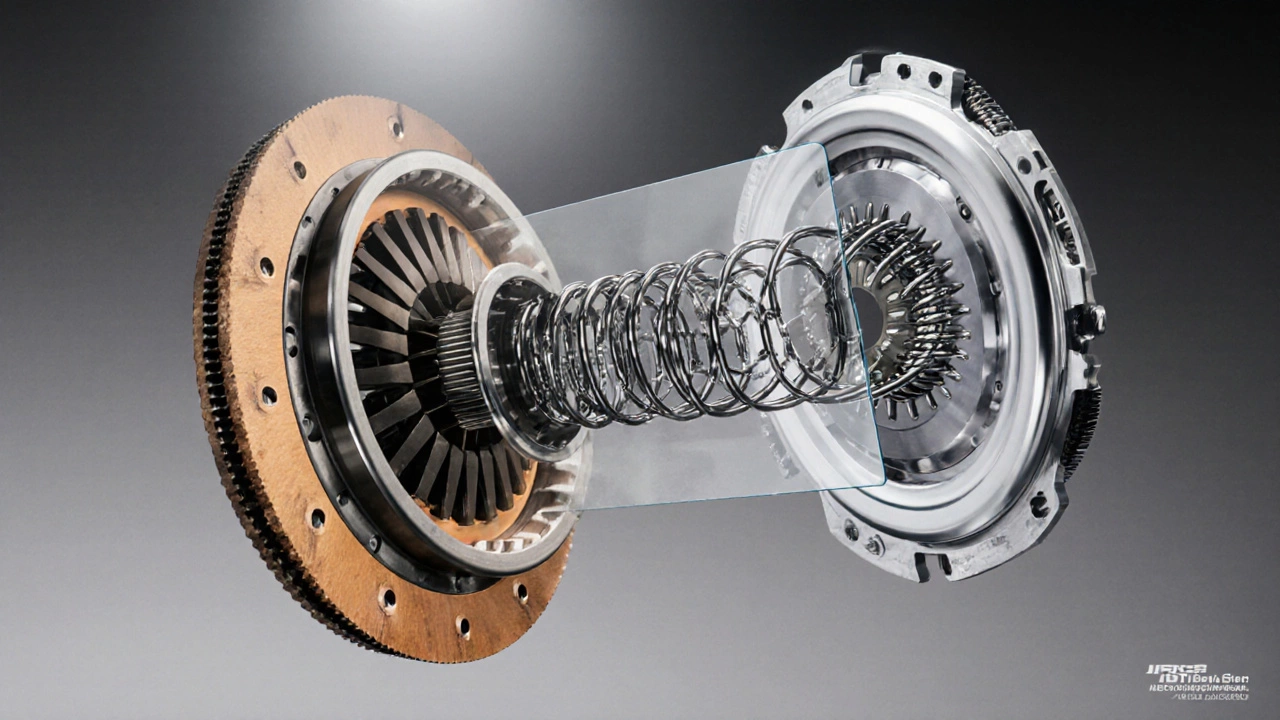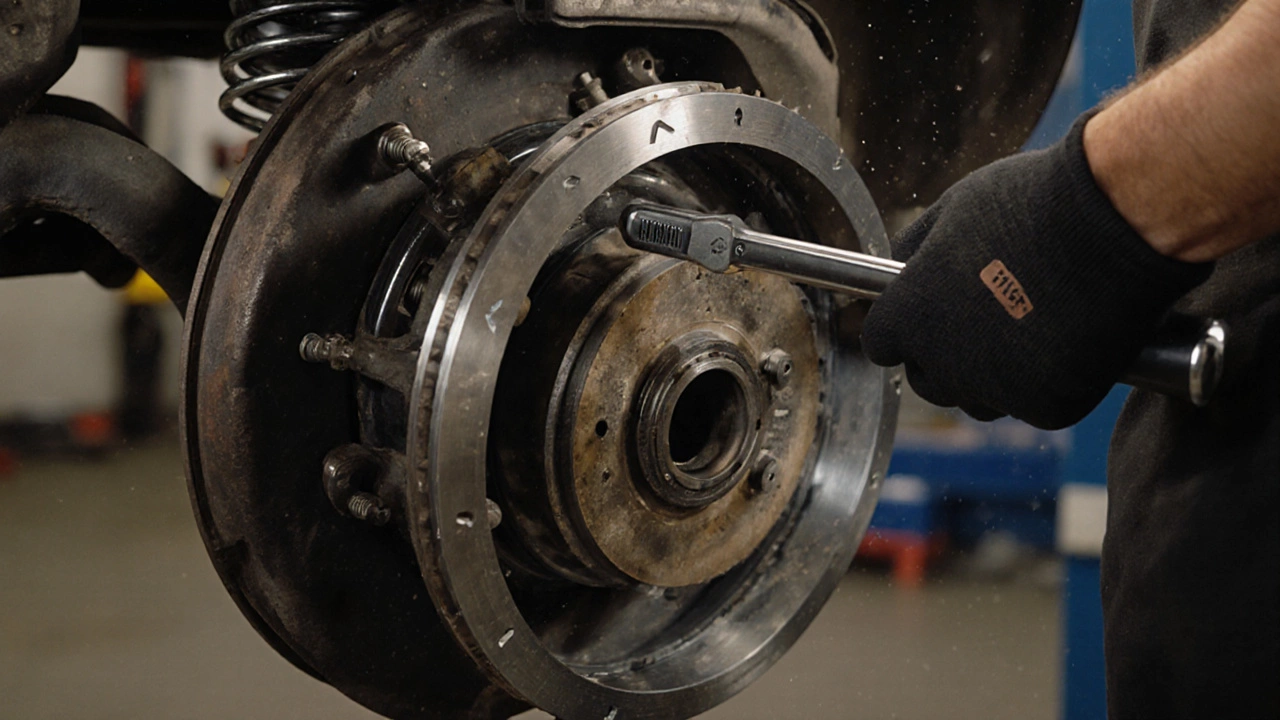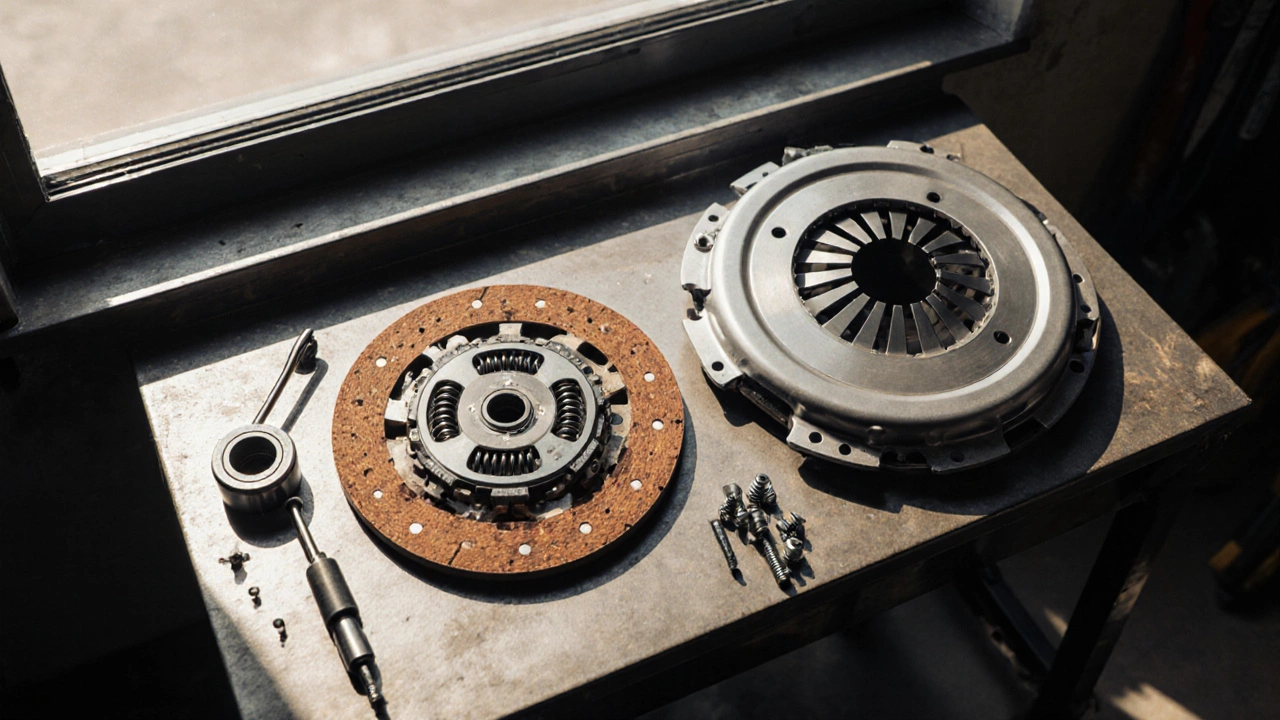Clutch Kit Comparison Calculator
Your Vehicle Information
Enter your vehicle details and driving conditions to get a personalized recommendation.
Key Takeaways
- A standard 2‑piece clutch kit contains a clutch disc and a pressure plate.
- Optional extras like a release bearing, alignment tool, or clutch spring are often sold separately.
- Understanding each component’s role helps you decide if a 2‑piece kit meets your repair needs.
- 2‑piece kits are cheaper than 3‑piece kits but may require you to source a compatible release bearing.
- Check torque specs and material type before installing to avoid premature wear.
When you open a 2 piece clutch kit, you’ll typically find two core components that work together to transfer engine power to the transmission. These are the clutch disca friction‑filled plate that mates with the flywheel and pressure plate and the pressure platethe steel housing that presses the disc against the flywheel. The kit may also include ancillary items such as a release bearingwhich allows the clutch fork to engage and disengage smoothly if the manufacturer bundles it, but most 2‑piece kits leave that part out.
Core Components Explained
Clutch Disc
- Function: Provides the friction surface that connects the engine’s flywheel to the transmission input shaft.
- Material: Commonly uses organic (ceramic‑filled), semi‑metallic, or ceramic friction compounds. Organic discs are quieter and smoother, while semi‑metallic handle higher torque.
- Key specs: Diameter (usually 9‑12 inches), thickness (around 1‑2mm), and friction coefficient (0.30‑0.45 for typical road cars).
Pressure Plate
- Function: Converts the clutch pedal’s mechanical or hydraulic force into pressure that squeezes the disc against the flywheel.
- Design: Most modern pressure plates are dual‑coil with a series of springs that provide a progressive bite point.
- Key specs: Number of springs (usually 6‑8), bolt pattern (e.g., 6×92mm for many V‑type engines), and torque rating (often 100‑150Nm for tightening to the flywheel).
What’s Usually Not Included?
Because the kit is called “2‑piece”, it deliberately omits a few parts that you’ll need for a full clutch replacement:
- Release bearing - If your current bearing is worn, you’ll have to buy a separate one.
- Clutch fork or hydraulic slave cylinder - These are part of the vehicle’s actuation system, not the kit.
- Flywheel - Most mechanics resurface the existing flywheel rather than replace it, unless it’s cracked.
- Clutch alignment tool - Helpful for getting the disc centered on the flywheel, often sold as a cheap add‑on.

When to Choose a 2‑Piece Kit
A 2‑piece kit makes sense if:
- Your existing release bearing is still in good condition (no noise, smooth operation).
- You’re on a tight budget - 2‑piece kits can be 30‑40% cheaper than full 3‑piece kits.
- You’re performing a routine replacement rather than a high‑performance upgrade.
If you’re rebuilding a high‑torque engine, swapping to a heavy‑duty clutch, or the bearing shows signs of wear, a 3‑piece kit (disc, pressure plate, and bearing) is the safer route.
Comparison: 2‑Piece vs 3‑Piece Clutch Kits
| Aspect | 2‑Piece Kit | 3‑Piece Kit |
|---|---|---|
| Included Parts | Clutch disc + pressure plate | Clutch disc + pressure plate + release bearing |
| Typical Cost (UK, 2025) | £120‑£180 | £180‑£260 |
| Installation Time | 1.5‑2hrs (if bearing reused) | 2‑2.5hrs (new bearing) |
| Best For | Standard‑type daily drivers, budget repairs | Performance builds, vehicles with worn bearings |
| Risk of Premature Wear | Higher if bearing is marginal | Lower - fresh bearing matches new disc |
Step‑by‑Step: Installing a 2‑Piece Kit
- Gather tools: socket set, torque wrench (max 150Nm), clutch alignment tool, and a clean workspace.
- Remove the transmission: support the engine, disconnect the driveshaft, and slide the gearbox back.
- Inspect the flywheel: look for cracks or hot spots. If needed, resurface it to a smooth finish (usually 0.2mm).
- Press the old clutch disc off the flywheel using a disc puller.
- Clean the flywheel surface with a lint‑free cloth and a brake‑cleaner spray.
- Place the new clutch disc on the flywheel. Use the alignment tool to centre it; the tool’s guide should line up with the six‑bolt pattern.
- Position the new pressure plate over the disc, ensuring the spring cup faces the correct direction (usually marked on the plate).
- Torque the pressure‑plate bolts in a criss‑cross pattern to the manufacturer’s spec - typically 100Nm for the first pass, then an additional 20Nm.
- Re‑install the transmission, reconnect the driveshaft, and refill any lost transmission fluid.
- Test the clutch pedal travel. If the bite point feels too high, double‑check the release bearing clearance - even a 2‑piece kit can suffer if the bearing is borderline.

Common Pitfalls and How to Avoid Them
- Skipping the alignment tool: An off‑centre disc causes uneven wear and chatter.
- Using the wrong pressure‑plate spring type: Dual‑coil plates need the correct spring direction; a single‑coil plate on a high‑torque engine will slip.
- Over‑torquing bolts: Excessive torque can distort the flywheel or crack the pressure plate.
- Re‑using a worn release bearing: Even though the kit doesn’t include it, a failing bearing will produce whine and shorten disc life.
Price Range and Quality Indicators
In the UK market (October2025), a reputable 2‑piece kit from brands like LUK, Sachs, or Exedy typically sits between £120 and £180. Lower‑priced kits may use cheap organic friction material that fades quickly, while premium kits often feature ceramic‑enhanced compounds that last 30‑40% longer.
Key quality cues to watch for:
- Clear friction‑material grade on the disc (e.g., “Semi‑Metallic - 70%”).
- Stamped torque‑specs on the pressure‑plate backing plate.
- Factory‑tested spring cup shape (dual‑coil is usually a sign of a higher‑end kit).
Choosing the Right Kit for Your Car
Match the kit to your vehicle’s make, model, and engine size. For example, a 1.6‑litre Ford Fiesta (2023) often uses a 9‑inch disc with a 6‑spring pressure plate, while a 2.0‑litre Subaru WRX (2024) needs a 10‑inch disc and a 8‑spring high‑torque plate.
If you’re unsure, consult the vehicle’s service manual or use an online fit‑guide that cross‑references engine codes with clutch dimensions.
Frequently Asked Questions
Do I need a new release bearing with a 2‑piece kit?
Only if the old bearing shows any noise, excessive play, or visual wear. A brand‑new bearing eliminates a common cause of clutch chatter, but if the bearing is still solid, you can reuse it and save a few pounds.
Can I mix a disc from one brand with a pressure plate from another?
In most cases yes, as long as the disc’s diameter and spline count match the pressure‑plate’s bolt pattern. However, pairing a high‑performance disc with a cheap plate can limit clutch life, so it’s best to keep the brand line if you’re after reliability.
How long should a 2‑piece clutch last?
With normal city driving, expect 70‑100000km. Aggressive driving, heavy loads, or frequent stop‑and‑go can cut that in half. Choosing a semi‑metallic or ceramic disc can stretch the life a bit.
Is a 2‑piece kit suitable for a performance build?
Usually not. Performance builds benefit from a stronger pressure plate, upgraded springs, and a fresh release bearing - all packaged in a 3‑piece kit. A 2‑piece kit may slip under high torque.
What torque should I use when tightening the pressure‑plate bolts?
Follow the vehicle’s service manual - most modern cars specify 100Nm for the first pass, then a final 20Nm. Using a calibrated torque wrench is essential to avoid over‑tightening.

